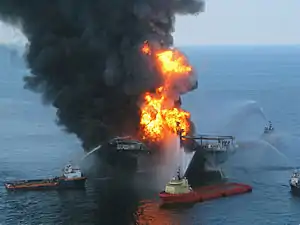GuLF Study
The GuLF Study, or Gulf Long-term Follow-up Study, is a five-year research project examining the human-health consequences of the Deepwater Horizon oil spill in April 2010.[1] The spill followed an explosion on a drilling rig leased by BP, the British oil company, and led to the release of over four million barrels of oil into the Gulf of Mexico, 48 miles off the coast of Louisiana in the United States.[3]
| GuLF Study | |
|---|---|
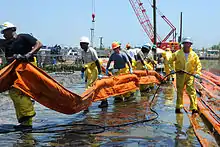 Workers carry an oil containment boom, Venice, Louisiana, May 2010. | |
| Name of study | Gulf Long-term Follow-up Study[1] |
| Initiated by | United States Department of Health and Human Services, June 2010 |
| Conducted by | National Institute of Environmental Health Sciences (NIEHS) |
| Launched | September 2010[2] |
| Principal investigator | Dale Sandler, chief of epidemiology, Division of Intramural Research, NIEHS |
| Staff scientist | Richard Kwok, Chronic Disease Epidemiology Group |
| Participants | 55,000 clean-up workers |
The study was set up in June that year by the United States Department of Health and Human Services. It is being conducted by the National Institute of Environmental Health Sciences (NIEHS), part of the National Institutes of Health, and aims to recruit 55,000 of the 150,000 workers who volunteered or were employed to help clean up the spill. It is led by Dale Sandler, head of the NIEHS's epidemiology branch.[4]
Deepwater Horizon oil spill
| Deepwater Horizon oil spill | |
|---|---|
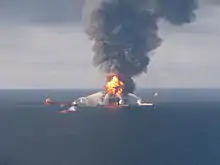 Fire crews tackle the blaze on the Deepwater Horizon oil rig, 21 April 2010. | |
| Name of drilling rig | Deepwater Horizon |
| Date of explosion | 20 April 2010 |
| Location of explosion | Macondo Prospect, near Louisiana, Gulf of Mexico |
| Companies involved | BP, Halliburton, Transocean |
| Areas affected | Alabama, Florida, Louisiana, Mississippi |
| Barrels of oil spilled | 4.9 million (some was recovered: 4.1 million (170 million US gallons or 643 million litres) agreed between the parties) |
| Spill depth | 5,000 ft (1,500 m) |
| Dispersant used | Nine million litres of Corexit 9527 and 9500 |
The Deepwater Horizon oil spill was the world's largest accidental marine oil spill.[5] It began on 20 April 2010 after an explosion on the Deepwater Horizon, a drilling rig leased by BP to drill an exploratory well.[6] Between then and 15 July, when the well was capped, over four million barrels of oil (around 170 million US gallons, or 643 million litres) spilled from a depth of 5,000 ft (1,500 m) into the Gulf of Mexico, 48 miles off the coast of Louisiana.[3]
According to the GuLF Study, the duration of the spill, the area affected, the proximity to local communities, and the number of people involved in the clean-up, were all greater than in any other spill that has been studied.[7] Around 180 miles of shoreline were "heavily to moderately oiled," according to a US government report.[8] Additional safety concerns were raised by the use of roughly nine million litres of oil dispersants, Corexit 9527 and 9500, during the clean-up operation. It was the largest known application of such dispersants to date,[9] and the first use of dispersants at that depth.[10]
Study details
Background and funding
Following the spill, there were anecdotal reports of health problems among workers involved in the clean-up, who complained of a variety of issues, including flu-like symptoms, rashes and stress. The Institute of Medicine held a workshop in June 2010, "Assessing the Human Health Effects of the Gulf of Mexico Oil Spill," and recommended that the United States government set up a study.[11] The Department of Health and Human Services agreed that month to set it up.[4] The study was launched in September 2010,[2] and in February 2011 the first mailing requests were sent out to potential participants.[12]
The study is expected to cost $34 million over five years,[13] and has been designed so that it can continue for up to 20 years.[4] The National Institutes of Health (NIH) contributed $10 million to fund the initial phases, and BP contributed an additional $10 million to NIH for this and other projects.[14] The BP funding was made through its Gulf of Mexico Research Initiative (GRI), a ten-year program to study the effects of the spill.[2]
Focus
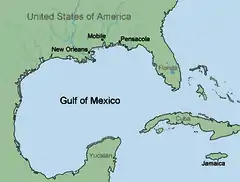
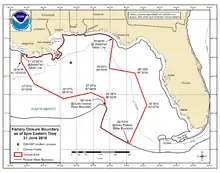
The areas affected are Alabama, Florida, Louisiana and Mississippi.[13] The study aims to track 55,000 workers for at least five years.[11] The workers will have been involved in a variety of tasks, such as oil burning, skimming, booming, as well as cleaning up animals, equipment and the shoreline, resulting in different levels of exposure to contaminants. The study has also recruited, as a control group, workers who completed the clean-up safety training, but who in the end did not take part in the clean-up itself.[14]
The researchers will examine the workers' exposure to volatile organic compounds (VOCs), polycyclic aromatic hydrocarbons (PAHs) and dispersants, using monitoring data gathered during the clean-up. Around 20,000 of the workers will be visited at home, and blood, hair, urine and toenail samples will be collected to look for biomarkers, such as DNA adducts and chromosome damage; lung-function tests will be carried out, and dust samples will be collected from their homes.[15]
Researchers will look for respiratory conditions, cancers, hematological outcomes, and neuro-behavioral or mental-health problems, and for any job losses, and financial or domestic disruption, the spill may have caused.[14] Questionnaires ask workers about their health at the time of the spill, exposure to oil or dispersant, and lifestyle factors that, as the study said, "might confound associations between exposures and health."[16] By January 2013 researchers had conducted 32,000 telephone interviews, including 800 interviews in Spanish and over 1,000 in Vietnamese, and 9,967 home visits.[17]
Obstacles and concerns
The difficulties facing the study are considerable. Sara Reardon wrote in Science in March 2011 that scientists were concerned that they did not know what to look for.[11] The delay between the workers' exposure in 2010 and the start of the study – the first interviews of participants took place in February 2011[18] – meant that short-term physical markers that could be directly related to the spill, such as rashes, had gone. There is also little information about the pre-spill baseline health of the workers, whose work involves regular exposure to environmental hazards. According to epidemiologist Maureen Lichtveld, the main health effects are likely to be psychosocial, such as depression and increased alcohol use resulting from job losses. Reardon wrote that, given how economically depressed the community is, it will be difficult to demonstrate what is causing the stress-related illnesses the workers report.[11]
There has been concern that the study will collect health information without addressing the medical needs of the workers, who may have no health insurance. The study's lead investigator, Dale Sandler, said in 2011 that participants who are found by the researchers to need medical care will be referred to local health-care providers who offer free or reduced-cost treatment. Local people say that finding such medical care is not easy, and that the workers' health should be prioritized over data collection.[18]
Notes
- "GuLF Study", National Institute of Environmental Health Sciences, 9 September 2012.
- "NIH to launch Gulf oil spill health study", National Institutes of Health, 7 September 2010.
- "U.S. Scientific Teams Refine Estimates of Oil Flow from BP's Well Prior to Capping", Deepwater Horizon Unified Command, 2 August 2010: "Overall, the scientific teams estimate that approximately 4.9 million barrels of oil have been released from the well. Not all of this oil and gas flowed into the ocean; containment activities conducted by BP under U.S. direction captured approximately 800,000 barrels of oil prior to the capping of the well."
- Harry R. Weber, "BP seeks to spread blame as first phase of spill trial ends", Houston Chronicle, 17 April 2013: "The government once estimated the spill was 4.9 million barrels, but agreed this year to lower that to 4.1 million barrels, about 172 million gallons. BP has disputed the government estimates."
- Charles W. Schmidt, "Study to Examine Health Effects in "Deepwater Horizon" Oil Spill Cleanup workers", Environmental Health Perspectives, 119(5), May 2011.
- Laura Moss, "The 13 largest oil spills in history", Mother Nature Network, 16 July 2010.
- Robert Bea, "Final report on the Investigation of the Macondo Well Blowout", Deepwater Horizon Study Group, Center for Catastrophic Risk Management, University of California, Berkeley, 1 March 2011, p. 6.
- "The GuLF STUDY", National Institute of Environmental Health Sciences, accessed 9 July 2013: "The oil spill in the Gulf of Mexico differed from previous spill in that the leak was at the ocean floor rather than on the surface. However, the area covered, the proximity to populated communities, the number of potentially exposed workers and community members, and the duration of the spill were far greater than any previously studied oil spills."
- "On Scene Coordinator Report: Deepwater Horizon Oil Spill", submitted to the National Response Team, September 2011, pp. v–vi.
- Melissa Gaskill, "How Much Damage Did the Deepwater Horizon Spill Do to the Gulf of Mexico?", Nature, 19 April 2011: "BP added around 9 million litres of chemical dispersants to the oil, roughly a third of it at depth."
- J. Wise and J.P. Wise Sr., "A review of the toxicity of chemical dispersants", Reviews on Environmental Health, 26(4), 2011, pp. 281–300: "Chemical dispersants used for the cleanup and containment of crude oil toxicity became a major concern after the 2010 Deepwater Horizon oil crisis in the Gulf of Mexico. During the crisis, millions of liters of chemical dispersants (Corexit 9527 and 9500) were used – the largest known application of dispersants in the field."
- Anderson, Aileen. "BP Deepwater Horizon Oil Spill," in S. George Philander (ed.), Encyclopedia of Global Warming and Climate Change, Second Edition, SAGE, 2012 (pp. 146–147), p. 147: "The spill was the first to release a huge amount of oil at a depth of nearly 5,000 ft (1,500 m), and the first to use dispersants at this depth."
- Sara Reardon, "Ten Months After Deepwater Horizon, Picking Up the Remnants of Health Data", Science, 331(6022), 11 March 2011, p. 1252.
- Jeffrey Ball, "Study to Track Gulf Cleanup Workers' Health", The Wall Street Journal, 22 February 2011.
- "U.S. to study health impact of BP oil spill", Reuters, 1 March 2011.
- "7 Sep 2010: NIH to Launch Gulf Oil Spill Health Study", National Institute of Environmental Health Sciences, 7 September 2010.
- "Home Visit Baseline Scripts and Questionnaires", GuLF Study, National Institute of Environmental Health Sciences, p. 5, accessed 9 July 2013:
- "During the visit, you'll be asked to:
"have your blood pressure, height, weight, hips, and waist measured
"blow into a machine to measure your lung function ...
"have a blood sample drawn and provide samples of urine, hair, and toenails
"complete a one-hour interview
"and allow our staff to collect a dust sample from your home."
- Charles W. Schmidt, "Study to Examine Health Effects in Deepwater Horizon Oil Spill Cleanup workers", Environmental Health Perspectives, 119(5), May 2011:
"In addition, investigators will collect samples of blood, hair, toenail, urine and other biospecimens from about half the participants to search for biomarkers showing some evidence of interaction with or influence on a biological process. DNA adducts, chromosome damage, and altered ability to repair DNA are examples of the sorts of biomarkers being considered."
- "NIH launches largest oil spill health study" Archived 2013-07-03 at the Wayback Machine, interview with Dale Sandler, GuLF Study lead investigator, National Institutes of Health, 15 March 2011:
Akinso: "Dr. Sandler explains that about 20,000 of the people who enroll in this study will participate in a home visit."
Sandler: "And that home visit will involve a very brief clinical exam, where we will measure lung function and blood pressure, height and weight and collect some biological blood samples."
- "During the visit, you'll be asked to:
- "The GuLF STUDY", National Institute of Environmental Health Sciences, accessed 9 July 2013.
- Mark Schleifstein, "BP Deepwater Horizon spill: Scientists say seafood safe, but health effects being measured", The Times-Picayune, 22 January 2013.
- Susan Buchanan, "BP spill workers seek care as health study progresses", The Louisiana Weekly, 21 November 2011.
Further reading
- "The GuLF STUDY", National Institute of Environmental Health Sciences, accessed 9 July 2013.
- "Deepwater Horizon Research Consortia", National Institute of Environmental Health Sciences, accessed 9 July 2013.
- "National Commission on the Deepwater Horizon Oil Spill and Offshore Drilling", oilspillcommission.gov, accessed 11 July 2013.
- "Final report", National Commission on the Deepwater Horizon Oil Spill and Offshore Drilling, 12 January 2011.
- Anderson, Aileen. "BP Deepwater Horizon Oil Spill", in S. George Philander (ed.), Encyclopedia of Global Warming and Climate Change, Second Edition, SAGE, 2012, pp. 146–147.
- Juhasz, Antonia. "Investigation: Two Years After the BP Spill, A Hidden Health Crisis Festers", The Nation, 18 April 2012.
- McCoy, Margaret A. and Salerno, Judith A. "Assessing the Effects of the Gulf of Mexico Oil Spill on Human Health", summary of the June 2010 workshop, Institute of Medicine, The National Academies Press, 2010.
- Mascarelli, Amanda. "Deepwater Horizon: After the oil", Nature, 467, September 2010, pp. 22–24.
- Waskey, Andrew Jackson. "BP", in S. George Philander (ed.), Encyclopedia of Global Warming and Climate Change, Second Edition, SAGE, 2012, pp. 144–146.
